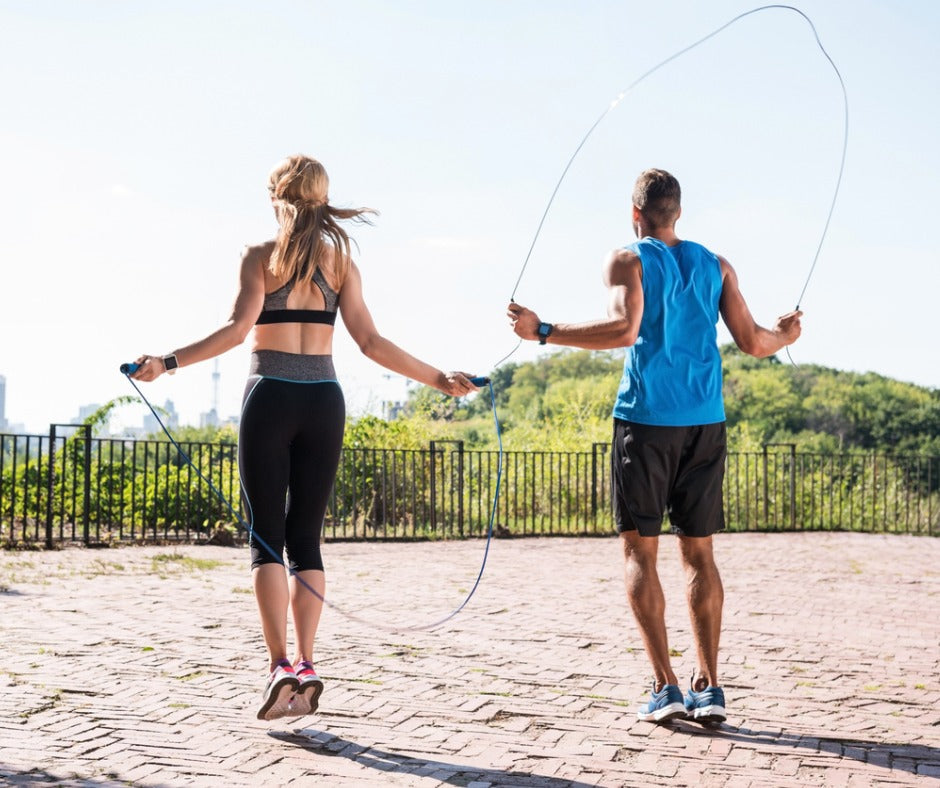Whilst many pieces of fitness equipment can prove to be quite expensive, there is one age-old exercise that can be bought on a shoestring (no pun intended!) – skipping! This can prove to be an excellent exercise for improving cardio fitness (especially anaerobic fitness), as well as enhancing coordination, balance and agility.
Whilst we all probably remember skipping from our school days – how can we adopt this as part of a modern day workout? To get some ideas we caught up with our in-house aerial fitness expert Heather Walker to help us “learn the ropes!”
Reminder!
Before we hand over to Heather, please remember that before starting any exercise programme you should always complete a PAR-Q and discuss any health concerns with your GP. You should never attempt an exercise that you are unconfident with or do anything that causes discomfort. Any exercise you are unsure about should be done under the supervision of a qualified exercise professional.
Skipping Rope Workout Ideas
Skipping rope exercise is great as it has many benefits. It provides a great cardiovascular workout, and as with any form of vigorous physical activity, it will help improve your heart rate, lower blood pressure and it can help with weight loss. The British Rope Skipping Association also advise that skipping can help improve balance, coordination and reaction time, as well as having psychological benefits such as improving your mood.
The great thing about skipping is it can be done any time, any place, as it uses portable equipment, and as skipping ropes are inexpensive, it's a great way of getting fit without breaking the bank. As it is a fairly simple exercise it is suitable for complete beginners right through to experienced athletes (a lot of boxers use skipping as part of their training).
Skipping can be used in an exercise routine as part of a warm-up, or as a main CV session and is often incorporated in circuits and HITT workouts. For personal trainers wanting to learn more about incorporating rope skipping into training routines, NRPT offers valuable resources and certifications to enhance your expertise in cardio workouts.
Here are the skipping rope exercises that I have come up with. Hopefully they all make sense!
- Regular bounce – one jump to every one full circle of the rope.
- Double bounce – two jumps for every one full circle of the rope.
- Double under – two full circles of the rope with every one jump.
- Cross arms – where you cross your arms in front of your body and continue to skip with your arms crossed.
- Cross and uncross arms – where you cross and uncross your arms continuously whilst skipping.
- Hopping – hopping on one foot.
- Alternating hopping – hopping from one foot to the other on each full circle of the rope.
- Front to back hop – where you put one foot in front of the other and hop from the back foot to the front foot as the rope passes underneath you, then hop back onto the back foot whilst the rope circles over your head.
- Running – running on the spot whilst circling the skipping rope around you.
- Jumping jacks – where you jump your legs open and close whilst circling the rope.
- Front jacks – where you jump one leg forwards and the other one back and then switch with each circle of the rope.
- Side swipe - where you bring the handles of the rope together and swipe the rope from one side of your body to the other, drawing an X with the rope.
You could use the above ideas to put together your own jump rope routine to build an effective jump rope cardio workout. For example, you could pick 5 of the above exercises and do each one for 30 seconds, with 30 seconds rest period in between. As you become more comfortable you could increase the work time or decrease the rest time, for example 40 seconds of work to 20 seconds of rest.
You could also start your jump rope workout with the easier exercises (regular bounce, double bounce) and then as you become more confident add in some of the harder variations, such as crossing and uncrossing your arms. This is a great way to use jump rope for fitness, as not only will your body be getting a workout, the coordination that is involved will help give your mind a workout too!
If you want to enhance your personal training career and learn how to teach clients rope skipping effectively, YMCA Awards offers a range of certifications to develop your skills.
Choosing your Skipping Rope
Something that you will need to consider for your skipping rope workout, is what type of rope you want to use. Although there are many different types and brands of jump rope, the three main types are speed ropes, beaded ropes and weighted ropes.
- Speed ropes are lighter and easier to use, so they are ideal for beginners. As the name suggests, these ropes are great for speed and can be great for endurance skipping, or working on footwork.
- Beaded ropes have beads covering the rope, which make a sound when they hit the floor, and so are commonly used at rhythmic jumping competitions. They are heavier than speed ropes, so they can be beneficial if doing technical jump rope exercises, but as they make a sound as they hit the floor, they can also be great for perfecting your timing.
- Weight ropes are heavy (up to 4.5kg or more) so they provide a more intense arm workout for your jump rope training. As they are heavier, they require more energy to move them, so they increase the intensity of the workout.
You will also need to determine the length of your rope. Usually, if you stand with the middle of the rope under your feet, the ends of the rope should come up to between the sternum and the shoulders, however you may have to experiment slightly to find the optimum rope length for you.
Summary - Skipping Workout Ideas
Thank you Heather! So, we have seen here that skipping is not just what we may have done in the old school days, more so it can be a modern and cost-effective method of training. Incorporating skipping into Personal Trainer sessions really could be “money for old rope!”. To find out more about Study Active courses please click here
References
Heather would like to give credit to the following websites who inspired her when writing this article.
https://www.brsa.org.uk/skipping-rope-as-sports-training/
https://www.brsa.org.uk/skip-yourself-fit/







